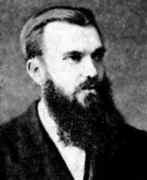Person: Clifford, William Kingdon

William Clifford was an English mathematician who studied non-euclidean geometry arguing that energy and matter are simply different types of curvature of space. He introduced what is now called a Clifford algebra which generalises Grassmann's exterior algebra.
Mathematical Profile (Excerpt):
- William Clifford Sn., born in Bishops Stortford, Hertfordshire, was a book seller, mainly of religious material, but also a prominent citizen of Exeter being an Alderman and a Justice of the Peace.
- William Sn. died quite young too, at the age of 58 in 1878.
- William showed great promise at school where he won prizes in many different subjects.
- This school was run by a Mr Templeton and in both 1858 and in the following year, Clifford sat the Cambridge University Local Examinations in a wide range of subjects, performing excellently in most of them.
- Clifford's first mathematics paper, written while he was at King's College, was The Analogues of Pascal's Theorem and it was published in The Quarterly Journal of Pure and Applied Mathematics in 1863.
- When he was 18 years old, in October 1863, William entered Trinity College, Cambridge, having won a Foundation Scholarship to study mathematics and natural philosophy (physics).
- Clifford signed in 1863 and 1864, but by the time he was required to sign in 1865 he seriously doubted whether he could do so in good faith but, after worrying about the act, nevertheless did sign.
- Frederick Pollock, one of his undergraduate friends, gives further details of Clifford's time as an undergraduate in his Introduction to Clifford's Lectures and Essays.
- In 1870 Clifford was part of the English Eclipse Expedition which sailed to Italy to obtain scientific data from an eclipse.
- In 1871 Clifford was appointed to the chair of Mathematics and Mechanics at University College, London.
- After Clifford's death, Lucy went on to write ten novels, seven collections of short stories and many plays and articles.
- Let us now look briefly at Clifford's mathematical contributions.
- Influenced by the work of Riemann and Lobachevsky, Clifford studied non-euclidean geometry.
- Given Clifford's brilliant and unconventional thinking, this is not impossible.
- Clifford generalised the quaternions (introduced by Hamilton two years before Clifford's birth) to what he called the biquaternions in his paper Preliminary Sketch of Biquaternions (1873) and he used them to study motion in non-euclidean spaces and on certain surfaces.
- These are now known as 'Clifford-Klein spaces'.
- Clifford also proved that a Riemann surface is topologically equivalent to a box with holes in it.
- He introduced Clifford algebras in his paper Applications of Grassmann's extensive algebra (1878).
- Note that here we have examples of Clifford unifying ideas in mathematics.
- As a teacher Clifford's reputation was outstanding.
- Not only was Clifford a highly original teacher and researcher, he was also a philosopher of science.
- Clifford delivered the lecture Right and wrong: the scientific ground of their distinction when he addressed the 'Sunday Lecture Society' on the afternoon of Sunday 7 November 1876.
- We have already seen that Clifford was a remarkable man in many ways.
- In 1876 Clifford suffered a physical collapse.
- Several events have been organised to honour Clifford's memory.
- A biographical commentary on William and Lucy will be interspersed with specialist contributions from eminent academics on topical mathematical, scientific, philosophical and literary subjects including the relationship between geometry and physics, the Darwinian controversy over science and religion, and mathematical and scientific education.
Born 4 May 1845, Exeter, Devon, England. Died 3 March 1879, Madeira Islands, Portugal.
View full biography at MacTutor
Tags relevant for this person:
Origin England
Thank you to the contributors under CC BY-SA 4.0! 

- Github:
-

- non-Github:
- @J-J-O'Connor
- @E-F-Robertson
References
Adapted from other CC BY-SA 4.0 Sources:
- O’Connor, John J; Robertson, Edmund F: MacTutor History of Mathematics Archive
